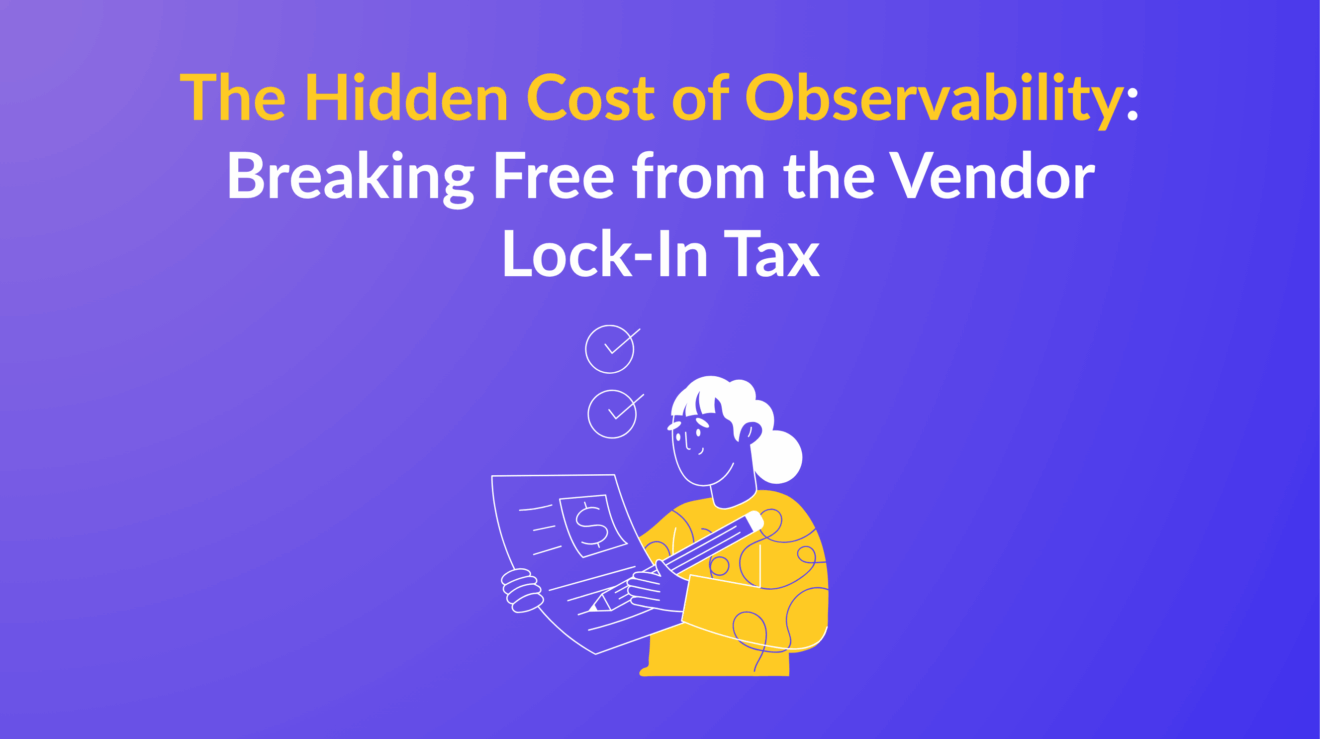How enterprise IT teams can reduce monitoring costs by up to 40% without sacrificing visibility.
Enterprise IT leaders are facing an uncomfortable reality: As their businesses grow and digital transformation accelerates, observability costs are spiraling out of control. What started as necessary investments in telemetry data management have become budget-breaking line items that seem to increase exponentially with every passing quarter.
If you’re reading this, chances are you’ve felt the pain firsthand. Maybe you’ve watched your Splunk or Datadog bills double in the past 18 months. Perhaps you’ve been forced to make difficult decisions about which data to keep and which to drop. Or maybe you’re simply tired of feeling trapped by vendors who seem to raise prices at will, knowing you can’t easily switch.
You’re not alone. And more importantly, you’re not powerless.
The Perfect Storm: Why Observability Costs Are Exploding

The observability cost crisis isn’t happening in a vacuum. It’s the result of several converging trends that have created a perfect storm for enterprise IT budgets:
1. The Data Volume Explosion
Digital transformation has accelerated data generation across every aspect of business operations. Telemetry data volumes are growing 30-50% annually in most enterprises, driven by:
- Cloud-native architectures generating more granular metrics
- Microservices proliferation creating exponentially more data points
- Remote work infrastructure requiring additional monitoring coverage
- IoT and edge computing adding new data sources
- Regulatory compliance demanding longer retention periods
2. Linear Pricing Models in an Exponential World
Traditional monitoring platforms weren’t designed for today’s data realities. Most still rely on pricing models that scale linearly with your growth:
- Per-host pricing that penalizes infrastructure expansion
- Per-GB ingestion fees that increase with data volume
- User-based licensing that grows with team size
- Feature-based tiers that force expensive upgrades
The result? A 200% increase in monitoring costs while your actual infrastructure costs may have only grown 50%.
3. The Vendor Lock-In Trap
Perhaps most frustrating is how difficult it becomes to address these cost increases. Traditional observability or monitoring platforms create vendor lock-in through:
- Proprietary data formats that make migration complex
- Custom dashboards and alerts that take months to recreate
- Specialized training and expertise that’s hard to replace
- Integration dependencies that touch multiple systems
This lock-in effect means you’re forced to accept whatever pricing increases come your way, with limited ability to negotiate or find alternatives.
4. Tool Sprawl and Operational Overhead
As teams try to solve specific monitoring challenges, they often add new tools to their stack. The average enterprise now uses 15+ different monitoring and observability tools, each with its own:
- Learning curve requiring specialized expertise
- Maintenance overhead consuming valuable IT resources
- Data silos preventing unified visibility
- Integration complexity creating operational friction
The Real Cost of "Cheap" Observability
When evaluating observability data management solutions, many organizations focus primarily on the direct costs—the monthly or annual fees paid to vendors. But the real cost of observability includes several hidden expenses that can dwarf the obvious ones:
Hidden Cost #1: Operational Overhead
Managing multiple tools requires significant human resources:
- Installation and configuration of new tools
- Ongoing maintenance and updates
- User training and knowledge transfer
- Troubleshooting integration issues
- Data correlation across different systems
Conservative estimates suggest that operational overhead can account for 60-80% of the total cost of ownership for monitoring solutions.
Hidden Cost #2: Data Loss and Downtime
When systems can’t handle traffic spikes or fail during critical moments, the business impact can be severe:
- Revenue loss from undetected outages
- Customer churn due to performance issues
- Regulatory fines from compliance failures
- Reputation damage from public incidents
A single major outage that goes undetected for even 30 minutes can cost more than an entire year of monitoring infrastructure.
Hidden Cost #3: Opportunity Cost
Resources spent managing observability infrastructure can’t be used for strategic initiatives:
- Innovation projects delayed by operational tasks
- Digital transformation slowed by monitoring complexity
- Competitive advantage lost to faster-moving rivals
- Team productivity reduced by tool sprawl
Hidden Cost #4: Vendor Dependency Risk
Being locked into a single vendor creates long-term strategic risks:
- Price increases that can’t be avoided
- Feature limitations that constrain your architecture
- End-of-life announcements that force expensive migrations
- Acquisition changes that alter product direction
The Anti-Vendor-Lock-In Alternative
What if there was a way to break free from this cycle? What if you could optimize your existing observability investments while gaining unprecedented control over your data and costs?
This is where the concept of a simplified telemetry pipeline becomes game-changing.
Understanding Telemetry Pipeline Architecture
Traditional observability follows a simple but limiting pattern:
Data Sources → Monitoring Platform → Vendor Lock-In
A simplified telemetry pipeline approach changes this fundamental architecture:
Data Sources → Smart Processing Layer → Your Choice of Tools
This architectural shift provides several key advantages:
- Vendor Neutrality Your data is processed and stored in open formats, giving you complete freedom to choose the best tools for each use case without migration pain.
- Cost Optimization Intelligent routing and filtering ensure you only pay for the data that provides business value, while less critical data can be stored more economically.
- Infinite Scalability Modern pipeline architectures can handle massive data volumes without the storage and compute limitations of traditional platforms.
- Zero Data Loss Advanced buffering and queuing mechanisms ensure no data is lost during traffic spikes or destination outages.
Real-World Impact: What Enterprises Are Achieving
Organizations that have implemented this simplified telemetry pipeline approach are seeing remarkable results:
Cost Reduction:
- Up to 40% reduction in total observability spending
- Transparent, predictable pricing that scales with value
- Elimination of vendor lock-in premium pricing
Operational Efficiency:
- 85% reduction in time spent managing data collectors
- Implementation in days rather than months
- Unified visibility across all telemetry data
Strategic Flexibility:
- Freedom to choose best-of-breed tools for specific needs
- Ability to adapt observability strategy as requirements change
- Complete control over data retention and compliance
The Geographic Advantage: Why Location Matters
For organizations operating in EMEA, there’s an additional consideration that’s becoming increasingly important: Data sovereignty and geopolitical risk.
The Swedish Advantage
Sweden’s position as a neutral, stable democracy with strong data protection laws makes it an ideal location for critical infrastructure services. For European organizations, partnering with a Swedish company provides:
Regulatory Alignment:
- GDPR compliance built into the architecture
- EU data residency requirements easily met
- Strong privacy protections by default
Geopolitical Stability:
- Reduced risk from changing international relations
- Stable regulatory environment
- Strong rule of law protections
Strategic Independence:
- Alternative to US-based platforms
- Reduced exposure to foreign government data requests
- Enhanced negotiating position with global vendors
Beyond Geography: Technical Excellence
While geographic advantages are important, they mean nothing without technical excellence. The most advanced telemetry pipeline solutions combine:
Kubernetes-Native Architecture:
- True elastic scaling that adapts to demand
- Cloud-native deployment across any environment
- Resilient, self-healing infrastructure
InstaStore™ Technology:
- Infinite data retention without storage limits
- Intelligent tiering between hot and cold storage
- Cost-effective long-term data preservation
Never Block, Never Drop Guarantee:
- Zero data loss even during extreme traffic spikes
- Intelligent buffering and queuing mechanisms
- Graceful degradation under load
Implementing the Anti-Vendor-Lock-In Strategy
Breaking free from vendor lock-in doesn’t require a disruptive “rip and replace” approach. The most successful implementations follow a complementary strategy:
Phase 1: Optimize Existing Investments
Rather than replacing your current observability tools, start by optimizing them:
- Intelligent data routing to reduce ingestion costs
- Smart filtering to eliminate noise and focus on value
- Flexible indexing to optimize storage costs
- Unified querying across multiple data sources
Phase 2: Add Centralized Management
Once your data flows are optimized, add centralized management capabilities:
- Agent management to reduce operational overhead
- Configuration consistency across environments
- Automated scaling based on demand
- Centralized monitoring of the monitoring infrastructure
Phase 3: Flexible Storage Options
Finally, add flexible storage options that give you complete control:
- Dual storage modes for different use cases
- Open data formats that prevent lock-in
- Retention policies that match business needs
- Compliance controls for regulated industries
Phase 4: Strategic Expansion
With the foundation in place, you can strategically expand your observability capabilities:
- Best-of-breed tools for specific use cases
- Advanced analytics and machine learning
- Custom integrations for unique requirements
- Future-proof architecture that adapts to change
The Path Forward: Taking Control of Your Observability Strategy
The observability cost crisis is real, but it’s not inevitable. By understanding the hidden costs of vendor lock-in and implementing an intelligent telemetry pipeline approach, you can:
Reduce Costs Immediately:
- Cut observability spending by up to 40%
- Eliminate vendor lock-in premium pricing
- Optimize existing tool investments
Gain Strategic Flexibility:
- Choose the right tools for each use case
- Adapt quickly to changing requirements
- Maintain complete control over your data
Future-Proof Your Investment:
- Avoid costly migrations and vendor dependencies
- Scale efficiently with business growth
- Stay ahead of evolving technology trends
Your Next Steps
If you’re ready to break free from the vendor lock-in tax and take control of your observability costs, here’s how to get started:
1. Assess Your Current State
Ask yourself these critical questions:
- Are you spending more than 15% of your IT budget on observability?
- Have your observability costs doubled in the past 2 years?
- Are you dropping data during traffic spikes?
- Would switching monitoring vendors require a 6+ month project?
- Do you have limited control over your telemetry data?
If you answered “yes” to two or more questions, you’re likely paying the vendor lock-in tax.
2. Calculate Your Potential Savings
Consider what a 40% reduction in observability costs would mean for your organization:
- How much budget could be redirected to innovation projects?
- What strategic initiatives could be accelerated?
- How would improved operational efficiency impact your team?
3. Explore the Anti-Vendor-Lock-In Approach
The time to act is now. Every day you wait is another day of paying the vendor lock-in tax. The intelligent telemetry pipeline approach isn’t just about reducing costs—it’s about regaining control over your observability strategy and positioning your organization for long-term success.
Your data should work for you, not against you.
Your observability strategy should enable growth, not constrain it.
Your vendor relationships should provide value, not create dependency.
Conclusion: The Anti-Vendor-Lock-In Imperative
The observability landscape is changing rapidly. Organizations that cling to traditional, vendor-locked approaches will find themselves at an increasing disadvantage—paying more for less flexibility while their competitors optimize costs and accelerate innovation.
The anti-vendor-lock-in approach isn’t just about technology—it’s about philosophy. It’s about believing that you should have complete control over your data, your costs, and your strategic direction. It’s about refusing to accept the status quo when a better way exists.
The question isn’t whether you can afford to implement an intelligent telemetry pipeline solution. The question is whether you can afford not to.
Maximum flexibility + visibility at the lowest cost per insight.
Your data. Your choice. Your control.
Ready to break free from vendor lock-in and reduce your observability costs by up to 40%? Learn how Apica’s simplified telemetry pipeline solution can optimize your existing investments while giving you complete control over your data and strategic direction.




